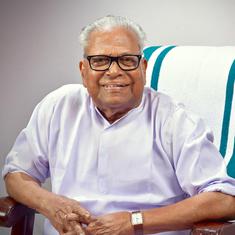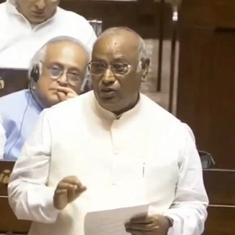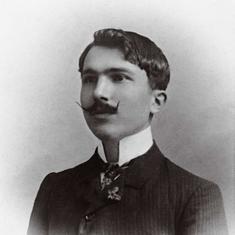“Monsoon and swell and drifting rain in the Indian Ocean,” Arthur Conan Doyle exclaimed as the SS Naldera approached Bombay in October 1920. “We heard that ‘thresh of the deep sea rain’ of which Kipling sings. Then at last in the early morning the long quay of Bombay, and the wonderful crowd of men of every race who await an incoming steamer.”
These words of the creator of Sherlock Holmes appeared in a collection of essays titled The Wanderings of a Spiritualist. His visit to Bombay was a brief stopover on the way to Australia and New Zealand, where he was slated to give a series of talks on Spiritualism – the belief that the living can communicate with the dead through so-called mediums.
Doyle was a known Spiritualist by then. Before leaving on the trip in September 1920, he had spent three years speaking on the subject around Britain despite earning ridicule from the press, Jesuits and other Christians. The public too seemed indifferent to the mockery he received. Large crowds would turn up to listen to him and Doyle decided to take his message to Australians, a people he was very fond of.
“I had spent some never-to-be-forgotten days with the Australian troops at the very crisis of the war,” he wrote. “My heart was much with them. If my message could indeed bring consolation to bruised hearts and to bewildered minds – and I had boxes full of letters to show that it did – then to whom should I carry it rather than to those who had fought so splendidly and lost so heavily in the common cause?”
Doyle said he was invited by “Spiritual bodies” to visit Australia to share his experiences as a Spiritualist. As the SS Naldera sailed through the Mediterranean Sea and the Suez Canal and onward to India, he would give lectures on Spiritualism in the ship’s chapel. “I was pleased to learn afterwards that among the most keen of my audience were every coloured man and woman on the ship, Parsees, Hindoos, Japanese and Mohammedans,” he said.
![A spirit photograph by Ada Deane featuring Doyle. Credit: Ada Deane/Wikimedia Commons [Public Domain].](https://sc0.blr1.cdn.digitaloceanspaces.com/inline/scuabiitsv-1729172402.jpg)
Before Doyle got off the ship to spend a day in Bombay – the first of his two visits to the city – he praised the people who formed the colonial apparatus in India. “Here at least half our passengers were disgorged, young subalterns, grey colonels, grave administrators, yellow-faced planters, all the fuel which is grown in Britain and consumed in the roaring furnace of India. So devoted to their work, so unthanked and uncomprehended by those for whom they work!”
If it were not for the British, he said, Pashtuns from the northwest would take over cities like Bombay and Calcutta, much in the same way as “the Picts and Scots flowed over Britain when the Roman legions were withdrawn”.
Although a firm supporter of the British Empire, Doyle seemingly had a soft corner for Indians. “One cannot spend even a single long day in India without carrying away a wonderful impression of the gentle dignity of the Indian people,” he wrote. “Our motor drivers were extraordinarily intelligent and polite, and all we met gave the same impression.”
The author’s first visit to Bombay lasted just a few hours and he kept his writings about the city to a minimum. “I observed some splendid types of manhood, however, among the native police,” he wrote. “We lunched at the Taj Mahal Hotel, and got back tired and full of mixed impressions.”
The Naldera departed from Bombay for Colombo, the capital of colonial Ceylon, where Doyle made another brief stopover before the long, non-stop journey to Fremantle in Western Australia.
Return journey
Doyle spent a few months touring Australia and New Zealand. On his way back, via the same route, he once again got off in Colombo and this time, travelled to the old hill capital, Kandy. Accompanying him everywhere on his journey were his wife, daughter, two sons, a maid and a secretary.
![Doyle with his family. Credit: Bain News Service/Library of Congress/Wikimedia Commons [Public Domain].](https://sc0.blr1.cdn.digitaloceanspaces.com/inline/rveqbcqean-1729172395.jpg)
From Ceylon, Doyle’s ship departed for Bombay in February 1921. “From Colombo to Bombay was a dream of blue skies and blue seas,” he wrote. “Half way up the Malabar coast, we saw the old Portuguese settlement of Goa, glimmering white on a distant hillside.”
What piqued the writer’s interest more was the HMS Malaya, a British naval battleship that participated in the Battle of Jutland, an Anglo-German confrontation that became the largest naval battle of the First World War. “We gazed upon it with the reverence that it deserved,” he said.
Seeing the “white Malaya steaming slowly upon deep blue summer seas, with the olive-green coast of Malabar on the horizon behind her,” Doyle was reminded of the Great War that had ended just a few years earlier. Among the millions of soldiers who were wounded in the conflict was his son Kingsley.
Kingsley survived the war but died of influenza in 1918 at the age of 25. Many thought Doyle turned to Spiritualism after this loss, but his interest in the spiritual realm went back decades.
Second visit
Doyle’s second stopover in Bombay was much longer. But neither he nor his family was bowled over by the city, it appears.
“Bombay is not an interesting place for the casual visitor,” he wrote, “and was in a state of uproar and decoration on account of the visit of the Duke of Connaught.” The duke in question, Prince Arthur, made a much-publicised trip that year to India, laying the foundation stone for India Gate in Delhi and introducing political reforms.
If there was something about Bombay that attracted the Doyles, it was the bazaars. “My wife and I did a little shopping, which gave us a glimpse of the patient pertinacity of the Oriental,” Doyle wrote.
At one shop, the writer offered to pay the Rs 150 bill by cheque, to which the merchant agreed. “When we reached the ship by steam-launch, we found that he, in some strange way, had got there already, and was squatting with the goods outside our cabin door,” Doyle wrote. “He looked askance at Lloyd’s Bank, of which he had never heard, but none the less he took the cheque under protest.”
![Doyle with his family. Credit: George Grantham Bain Collection/Library of Congress/Wikimedia Commons [Public Domain].](https://sc0.blr1.cdn.digitaloceanspaces.com/inline/prpktuffge-1729173977.jpg)
The merchant returned to the ship the next evening, carrying the “sweat-stained cheque” that he said could not be cashed. “This time I paid in English pound notes, but he looked upon them with considerable suspicion,” Doyle said. “As our ship was lying a good three miles from the shore, the poor chap had certainly earned his money, for his goods, in the first instance, were both good and cheap.”
During this trip, the Doyles had a chance to visit Elephanta Island, where the writer felt a sense of rage towards the Portuguese who vandalised its ancient caves.
“We have seen the Island of Elephanta, and may the curse of Ernulphus, which comprises all other curses, be upon that old Portuguese Governor who desecrated it, and turned his guns upon the wonderful stone carvings,” he wrote, referring to the curse from the 18th-century novel The Life and Opinions of Tristram Shandy, Gentleman. Ernulphus is a Catholic bishop in Laurence Sterne’s novel.
Despite the damage done to the caves, Doyle liked Elephanta. “It reminds me of Abou Simbel in Nubia, and the whole place has an Egyptian flavour. In a vast hollow in the hill, a series of very elaborate bas reliefs have been carved, showing Brahma, Vishnu and Siva, the old Hindoo trinity, with all those strange satellites, the bulls, the kites, the dwarfs, the elephant-headed giants with which Hindoo mythology has so grotesquely endowed them.”
Doyle used the visit to Elephanta to have a go at religion in general. “Surely a visitor from some wiser planet, examining our traces, would judge that the human race, though sane in all else, was mad the moment that it touched religion, whether he judged it by such examples as these, or by the wearisome iteration of expressionless Buddhas, the sacred crocodiles and hawk-headed gods of Egypt, the monstrosities of Central America, or the lambs and doves which adorn our own churches,” he wrote. “It is only in the Mohammedan faith that such an observer would find nothing which could offend, since all mortal symbolism is there forbidden.”
After observing worshippers at the island, he conceded that religious conceptions like the ones he attacked earlier “did indeed help these poor people through their journey of life”.
Strong allegiances
On his way to the island, Doyle had a brief opportunity to meet the indigenous people of Bombay. “Elephanta was a little bit of the old India, but the men who conveyed us there from the launch to the shore in their ancient dhows were of a far greater antiquity,” he wrote. “These were Kolis, small, dark men, who held the country before the original Aryan invasion, and may still be plying their boats when India has become Turanian or Slavonic, or whatever its next avatar may be. They seem to have the art of commerce well developed, for they held us up cleverly until they had extracted a rupee each, counting us over and over with great care and assiduity.”
The famous writer enjoyed the trip to the caves. “It was a pleasant break to our long voyage, and we were grateful to our commander, who made everything easy for us,” he wrote. “He takes the humane view that a passenger is not merely an article of cargo, to be conveyed from port to port, but that his recreation should, in reason, be considered as well.”
Doyle’s ship took 200 passengers on board from Bombay, including the Maharaja of Kapurthala, Jagatjit Singh.
As the steamship sailed away from Bombay, Doyle once again expressed his appreciation for both India and the Raj. “When we think how splendidly India helped us in the war, it would indeed be sad if a serious rift came between us now,” he wrote. “One thing I am very sure of, that if Great Britain should ever be forced to separate from India, it is India, and not Britain, which will be the chief sufferer.”
Ajay Kamalakaran is a writer, primarily based in Mumbai. His Twitter handle is @ajaykamalakaran.










